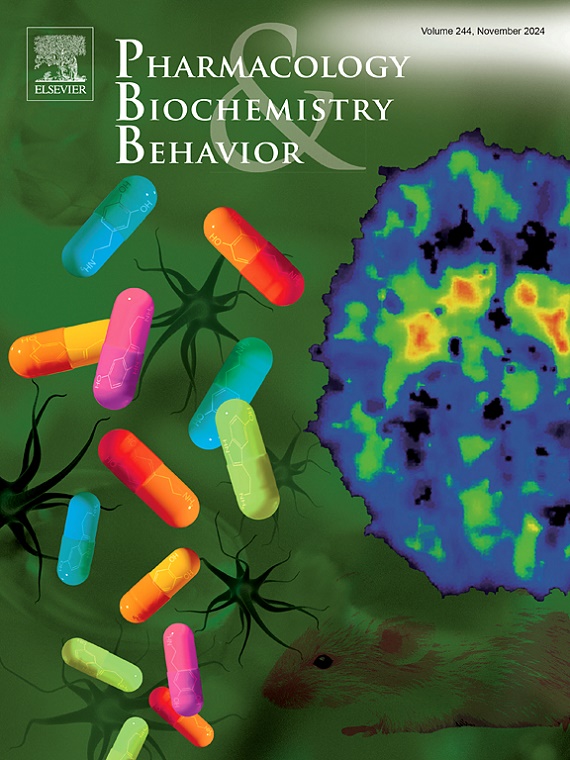年龄和性别依赖的内源性大麻素系统参与ADHD大鼠模型的运动和风险评估
IF 3.3
3区 心理学
Q1 BEHAVIORAL SCIENCES
引用次数: 0
摘要
注意缺陷多动障碍(ADHD)是一种影响各个年龄组个体的神经发育障碍。执行功能障碍是多动症的特征,通常与冒险行为水平升高有关。内源性大麻素系统在调节前额皮质回路中起着至关重要的作用。在这里,我们评估了大麻素CB1和CB2受体的急性药理操作对青春期和成年期ADHD动物模型的运动和风险评估/焦虑样行为的影响。此外,我们研究了两种年龄的前额皮质内源性大麻素系统成分(CB1、CB2、FAAH、MAGL)的蛋白水平和基因表达。在青春期,大麻素受体的激活加重了ADHD模型的多动和危险行为。这些行为特征在雌性大鼠中更为明显。在成年期,大麻素受体的操纵并没有改变多动症,但恶化了风险评估。总体而言,ADHD模型中内源性大麻素系统受体和酶的基因表达水平升高。我们的研究结果表明,内源性大麻素系统可能在ADHD中运作不同,操纵该系统,特别是在青少年中,可能会加剧抑制控制的缺陷。本文章由计算机程序翻译,如有差异,请以英文原文为准。

Age- and sex-dependent participation of the endocannabinoid system in locomotion and risk assessment of an ADHD rat model
Attention deficit hyperactivity disorder (ADHD) is a neurodevelopmental disorder affecting individuals across age groups. Impairments in executive function characterize ADHD and are often associated with elevated levels of risk-taking behaviors. The endocannabinoid system plays a crucial role in modulating prefrontal cortex circuits. Here, we assessed the effects of acute pharmacological manipulation of cannabinoid CB1 and CB2 receptors on locomotion and risk assessment/anxiety-like behaviors in an ADHD animal model during adolescence and adulthood. Further, we investigated the protein levels and gene expression of endocannabinoid system components (CB1, CB2, FAAH, MAGL) in the prefrontal cortex at both ages. During adolescence, activation of cannabinoid receptors aggravated the hyperactivity and risky behaviors of the ADHD model. These behavioral traits were more evident in female rats. In adulthood, manipulation of cannabinoid receptors did not alter hyperactivity but worsened risk assessment. Overall, gene expression levels of receptors and enzymes of the endocannabinoid system were increased in the ADHD model. Our findings suggest that the endocannabinoid system may operate differently in ADHD, and manipulating this system, especially in adolescents, could exacerbate deficits in inhibitory control.
求助全文
通过发布文献求助,成功后即可免费获取论文全文。
去求助
来源期刊
CiteScore
6.40
自引率
2.80%
发文量
122
审稿时长
38 days
期刊介绍:
Pharmacology Biochemistry & Behavior publishes original reports in the areas of pharmacology and biochemistry in which the primary emphasis and theoretical context are behavioral. Contributions may involve clinical, preclinical, or basic research. Purely biochemical or toxicology studies will not be published. Papers describing the behavioral effects of novel drugs in models of psychiatric, neurological and cognitive disorders, and central pain must include a positive control unless the paper is on a disease where such a drug is not available yet. Papers focusing on physiological processes (e.g., peripheral pain mechanisms, body temperature regulation, seizure activity) are not accepted as we would like to retain the focus of Pharmacology Biochemistry & Behavior on behavior and its interaction with the biochemistry and neurochemistry of the central nervous system. Papers describing the effects of plant materials are generally not considered, unless the active ingredients are studied, the extraction method is well described, the doses tested are known, and clear and definite experimental evidence on the mechanism of action of the active ingredients is provided.

 求助内容:
求助内容: 应助结果提醒方式:
应助结果提醒方式:


